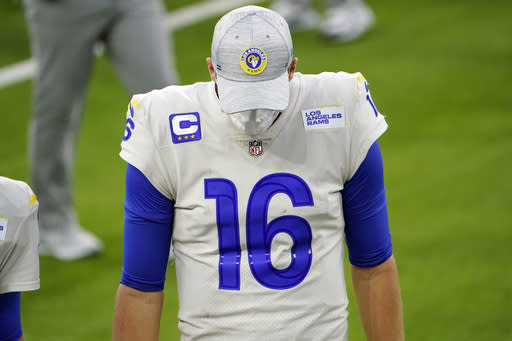When the football squirted out of A.J. Dillon’s grasp, it shot straight back, coming to a rest right at the feet of his quarterback. Aaron Rodgers calmly stooped down to pick it up and managed to lunge forward for a few yards. Three plays later, Rodgers found Allen Lazard for a 58-yard touchdown pass that put the Packers up by two scores with less than seven minutes to play.
The ball is, literally, bouncing the Packers’ way—and it feels like their year.
With a 32–18 divisional round win against the Rams, Green Bay advanced to the NFC championship game—where the team’s 2019 season ended. The 49ers dominated them in that game, building a 27–0 halftime lead with the best single-half rushing performance since the 1960s. Rodgers admitted afterward that the loss hurt more than earlier in his career, because he understood how difficult it is to get to that spot.
Now 37, and in his 16th NFL season, Rodgers also has an awareness of how the opportunities dwindle with each passing year—a reality exacerbated, too, by the team’s drafting of QB Jordan Love in the first round of April’s draft. Which makes even more significant how good the Packers look this season. There’s no question they are a better team than the one whose season ended in Santa Clara last January (even if their 13–3 regular-season record was the same).
Matt LaFleur’s offense has continued to flourish in his second season leading the team, as evidenced by the ridiculous stat shared on the broadcast: Rodgers has thrown 21 touchdowns off play-action this season, including that long one to Lazard, and no interceptions. Their three-headed monster at running back was on full display in this game, with Aaron Jones, Jamaal Williams and Dillon combining for 191 rushing yards, often running through wide-open holes created by a dominant Packers front that has held together despite the loss of All-Pro left tackle David Bakhtiari. And look no further than how the defense stifled the Rams on their final possession, one they had to score on to keep the game alive: Jaire Alexander sprinted up to tackle Robert Woods for a loss, and on fourth down, Za’Darius Smith’s inside pressure set up Rashan Gary’s sack from the outside.
And, of course, there is Rodgers. The likely MVP has always had the ability to make dazzling plays, and the first game of the divisional round was no exception. There was his one-yard TD pass to Davante Adams, on which he appeared to send Adams across the formation and back again, ensuring that there was no way Rams CB Jalen Ramsey could effectively cover him, then fired off the quick pass with a blitzer in his face. Perhaps the most marvelous was Rodgers’s one-yard TD run, when his devastating pump-fake got Leonard Floyd to jump up and try to bat a pass down instead of tackling Rodgers, who had just enough space to scoot to the right and get to the pylon.
It’s been a decade since the Packers have played in, and won, a Super Bowl, back when Rodgers was only in his third season as a starter. In the 2014 season, he played through a late-season calf strain that diminished his mobility but was still one mishandled onside kick in Seattle away from the Super Bowl. They lost to Atlanta in the conference championship in the 2016 season, followed by two years without making the postseason, which ultimately set up the ushering in of the LaFleur era.
There was a bit of a bumpy start for the new coach and QB, with a lot of conversation about how the young offensive mind would mesh with the veteran QB, and how much control Rodgers would have in his offensive system. But the pairing has been an unquestionable success.
Next week, Rodgers and the Packers will face either Tom Brady and the Buccaneers or Drew Brees and the Saints. It will be a matchup for the ages, each team led by a Hall of Fame QB looking for the opportunity to go win another ring. Rodgers’s 42- or 43-year-old foe will be a reminder that he may still have several more seasons ahead of him. But there’s no time, or team, like the present, and this is starting to look a lot like the Packers’ year.






